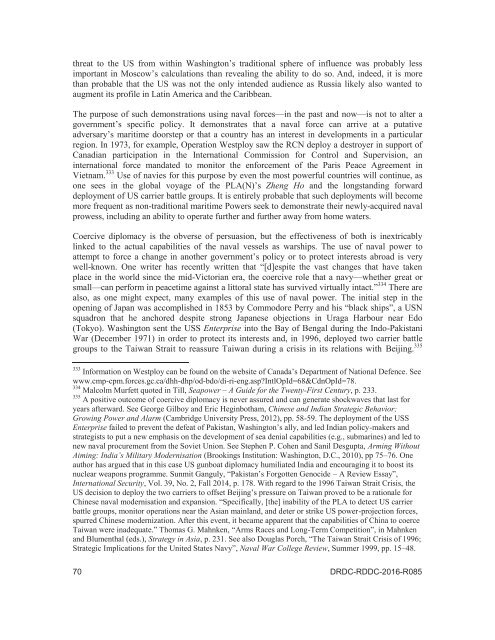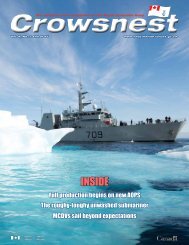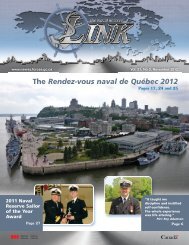You also want an ePaper? Increase the reach of your titles
YUMPU automatically turns print PDFs into web optimized ePapers that Google loves.
threat to <strong>the</strong> US from within Washington’s traditional sphere <strong>of</strong> influence was probably less<br />
important in Moscow’s calculations than revealing <strong>the</strong> ability to do so. And, indeed, it is more<br />
than probable that <strong>the</strong> US was not <strong>the</strong> only intended audience as Russia likely also wanted to<br />
augment its pr<strong>of</strong>ile in Latin America <strong>and</strong> <strong>the</strong> Caribbean.<br />
<strong>The</strong> purpose <strong>of</strong> such demonstrations using naval forces—in <strong>the</strong> past <strong>and</strong> now—is not to alter a<br />
government’s specific policy. It demonstrates that a naval force can arrive at a putative<br />
adversary’s maritime doorstep or that a country has an interest in developments in a particular<br />
region. In 1973, for example, Operation Westploy saw <strong>the</strong> RCN deploy a destroyer in support <strong>of</strong><br />
Canadian participation in <strong>the</strong> International Commission for Control <strong>and</strong> Supervision, an<br />
international force m<strong>and</strong>ated to monitor <strong>the</strong> enforcement <strong>of</strong> <strong>the</strong> Paris Peace Agreement in<br />
Vietnam. 333 Use <strong>of</strong> navies for this purpose by even <strong>the</strong> most powerful countries will continue, as<br />
one sees in <strong>the</strong> global voyage <strong>of</strong> <strong>the</strong> PLA(N)’s Zheng Ho <strong>and</strong> <strong>the</strong> longst<strong>and</strong>ing forward<br />
deployment <strong>of</strong> US carrier battle groups. It is entirely probable that such deployments will become<br />
more frequent as non-traditional maritime <strong>Power</strong>s seek to demonstrate <strong>the</strong>ir newly-acquired naval<br />
prowess, including an ability to operate fur<strong>the</strong>r <strong>and</strong> fur<strong>the</strong>r away from home waters.<br />
Coercive diplomacy is <strong>the</strong> obverse <strong>of</strong> persuasion, but <strong>the</strong> effectiveness <strong>of</strong> both is inextricably<br />
linked to <strong>the</strong> actual capabilities <strong>of</strong> <strong>the</strong> naval vessels as warships. <strong>The</strong> use <strong>of</strong> naval power to<br />
attempt to force a change in ano<strong>the</strong>r government’s policy or to protect interests abroad is very<br />
well-known. One writer has recently written that “[d]espite <strong>the</strong> vast changes that have taken<br />
place in <strong>the</strong> world since <strong>the</strong> mid-Victorian era, <strong>the</strong> coercive role that a navy—whe<strong>the</strong>r great or<br />
small—can perform in peacetime against a littoral state has survived virtually intact.” 334 <strong>The</strong>re are<br />
also, as one might expect, many examples <strong>of</strong> this use <strong>of</strong> naval power. <strong>The</strong> initial step in <strong>the</strong><br />
opening <strong>of</strong> Japan was accomplished in 1853 by Commodore Perry <strong>and</strong> his “black ships”, a USN<br />
squadron that he anchored despite strong Japanese objections in Uraga Harbour near Edo<br />
(Tokyo). Washington sent <strong>the</strong> USS Enterprise into <strong>the</strong> Bay <strong>of</strong> Bengal during <strong>the</strong> Indo-Pakistani<br />
War (December 1971) in order to protect its interests <strong>and</strong>, in 1996, deployed two carrier battle<br />
groups to <strong>the</strong> Taiwan Strait to reassure Taiwan during a crisis in its relations with Beijing. 335<br />
333 Information on Westploy can be found on <strong>the</strong> website <strong>of</strong> Canada’s Department <strong>of</strong> National Defence. See<br />
www.cmp-cpm.forces.gc.ca/dhh-dhp/od-bdo/di-ri-eng.asp?IntlOpId=68&CdnOpId=78.<br />
334 Malcolm Murfett quoted in Till, Seapower – A Guide for <strong>the</strong> Twenty-First Century, p. 233.<br />
335 A positive outcome <strong>of</strong> coercive diplomacy is never assured <strong>and</strong> can generate shockwaves that last for<br />
years afterward. See George Gilboy <strong>and</strong> Eric Heginbotham, Chinese <strong>and</strong> Indian Strategic Behavior;<br />
Growing <strong>Power</strong> <strong>and</strong> Alarm (Cambridge University Press, 2012), pp. 58-59. <strong>The</strong> deployment <strong>of</strong> <strong>the</strong> USS<br />
Enterprise failed to prevent <strong>the</strong> defeat <strong>of</strong> Pakistan, Washington’s ally, <strong>and</strong> led Indian policy-makers <strong>and</strong><br />
strategists to put a new emphasis on <strong>the</strong> development <strong>of</strong> sea denial capabilities (e.g., submarines) <strong>and</strong> led to<br />
new naval procurement from <strong>the</strong> Soviet Union. See Stephen P. Cohen <strong>and</strong> Sanil Desgupta, Arming Without<br />
Aiming: India’s Military Modernisation (Brookings Institution: Washington, D.C., 2010), pp 75–76. One<br />
author has argued that in this case US gunboat diplomacy humiliated India <strong>and</strong> encouraging it to boost its<br />
nuclear weapons programme. Sunmit Ganguly, “Pakistan’s Forgotten Genocide – A Review Essay”,<br />
International Security, Vol. 39, No. 2, Fall 2014, p. 178. With regard to <strong>the</strong> 1996 Taiwan Strait Crisis, <strong>the</strong><br />
US decision to deploy <strong>the</strong> two carriers to <strong>of</strong>fset Beijing’s pressure on Taiwan proved to be a rationale for<br />
Chinese naval modernisation <strong>and</strong> expansion. “Specifically, [<strong>the</strong>] inability <strong>of</strong> <strong>the</strong> PLA to detect US carrier<br />
battle groups, monitor operations near <strong>the</strong> Asian mainl<strong>and</strong>, <strong>and</strong> deter or strike US power-projection forces,<br />
spurred Chinese modernization. After this event, it became apparent that <strong>the</strong> capabilities <strong>of</strong> China to coerce<br />
Taiwan were inadequate.” Thomas G. Mahnken, “Arms Races <strong>and</strong> Long-Term Competition”, in Mahnken<br />
<strong>and</strong> Blumenthal (eds.), Strategy in Asia, p. 231. See also Douglas Porch, “<strong>The</strong> Taiwan Strait Crisis <strong>of</strong> 1996;<br />
Strategic Implications for <strong>the</strong> United States Navy”, <strong>Naval</strong> War College Review, Summer 1999, pp. 15–48.<br />
70 DRDC-RDDC-2016-R085




